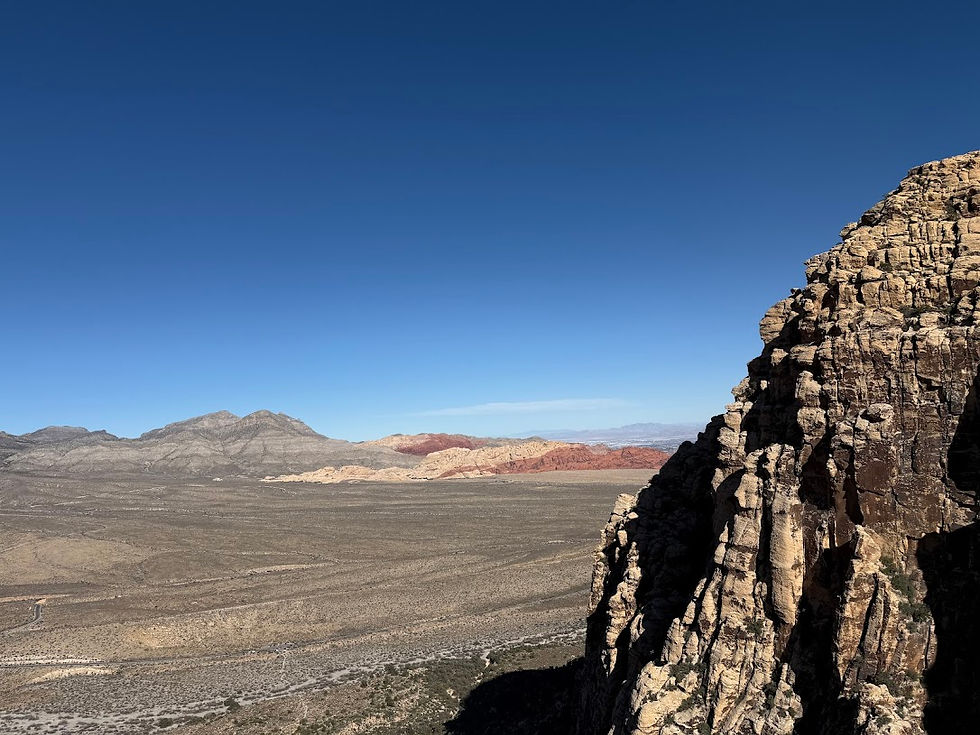Unveiling Red Rock Canyon's Secrets: A Geologist's Guide for Hikers and Climbers
- Mike Donaldson
- Aug 6
- 4 min read
Updated: Aug 7
Red Rock Canyon, just a short drive from Las Vegas, Nevada, is a breathtaking wonder that captures the hearts of visitors with its striking cliffs and diverse geology. The canyon’s vibrant red rocks and unique formations tell a story that stretches back millions of years, making it an exciting spot for hikers and climbers alike. This guide will explore the canyon's geological formations, including the Keystone Thrust fault, the transformation of ancient sand dunes into the stunning Aztec Sandstone, and the reasons behind the canyon's eye-catching red color.
Discovering the geology of Red Rock Canyon will enhance your experience as you hike its trails, allowing you to connect your adventures with the Earth’s fascinating history. Let’s embark on this exciting journey!

The Keystone Thrust Fault
Among the most significant geologic features of Red Rock Canyon is the Keystone Thrust fault. This fault line has greatly influenced the landscape we admire today. The Keystone Thrust is a geological structure where rock layers have been pushed over one another due to tectonic activity.
About 65 million years ago, during the Laramide Orogeny, two tectonic plates—the North American and Pacific plates—collided. This catastrophic event generated enormous pressure, causing older limestone layers to be thrust over younger volcanic rocks. Today, hikers can witness this striking rock display firsthand.
Moreover, the Keystone Thrust is a hotspot for climbers. It provides various climbing routes that enable adventurers to explore different rock types and formations with varying difficulty levels. For example, one popular route called "Pine Creek Canyon" offers climbers a moderate level of challenge with some breathtaking views of these fascinating geological layers.

Ancient Sand Dunes Turned to Aztec Sandstone
To truly appreciate Red Rock Canyon's remarkable landscape, it’s essential to understand the transformation of ancient sand dunes into Aztec Sandstone. Roughly 250 million years ago, this region was a vast desert featuring extensive sand dunes. Over time, layers of sediment buried these dunes, compressing them under immense weight.
This process led to the formation of sandstone, specifically Aztec Sandstone, known for its stunning colors and distinctive patterns. The rich red and orange hues visible throughout Red Rock Canyon largely result from iron oxide, which gives the sandstone its signature look.
While hiking along trails like the "Calico Hills," you can observe the unique textures and lines in the Aztec Sandstone. These layers tell stories of Earth's climatic changes over millions of years. If you take a moment to look closely, you can see fossils within the stone, providing a direct link to ancient life.
Why the Red Color Exists: Iron Oxidation
The eye-catching red color of Red Rock Canyon's rock formations is the result of a natural process known as iron oxidation. The desert environment, rich in iron minerals, has undergone oxidation from exposure to water and air for thousands of years. When iron particles within the rock oxidize, they take on a reddish hue, creating the captivating landscapes that attract countless visitors today.
This vibrant coloration not only enhances the canyon’s beauty but also highlights the geological processes that have shaped our planet. The striking reds and earthy tones contrast sharply against the clear blue sky, offering an unforgettable experience for anyone hiking the area.
As you journey through the trails, take a moment to appreciate this natural spectacle. Understanding the reason behind the red rocks changes your outlook and deepens your connection with the rich environmental history of Red Rock Canyon.
Tectonic Collision History
The geological history of Red Rock Canyon is deeply connected to tectonic collisions that have occurred throughout the ages. The canyon's formation is a testament to the dynamic processes shaping the Earth's crust.
Ongoing interactions between tectonic plates have led to uplift, folding, and faulting of rock layers. Each collision has sculpted the towering cliffs and deep valleys defining Red Rock Canyon today. Did you know that the canyon's elevation varies from 3,800 to over 7,000 feet? This impressive range offers diverse habitats for flora and fauna unique to the region.
These tectonic activities not only shaped the landscape but also provided a variety of ecosystems. This diversity makes the canyon an intriguing area for both exploration and conservation efforts. Understanding this tectonic history allows hikers and climbers to appreciate the geological significance—this area is not just a playground; it's a living record of Earth's vibrant past waiting to be explored.
Basic Glossary of Geology Terms
To help clarify some of the geological terms we've discussed, here’s a simple glossary:
Tectonic Plates: Large pieces of the Earth's crust that move and interact, causing geological features and events like earthquakes.
Thrust Fault: A fault where rock layers are pushed over one another, caused by pressure from tectonic forces.
Sedimentary Rock: Rock formed from the accumulation of sediments, often layered and may contain fossils.
Oxidation: A chemical reaction where elements, such as iron, react with oxygen, often altering color.
Sandstone: A type of sedimentary rock made up mainly of sand-sized mineral particles.
Grasping these terms can enhance your hiking experience, making the fascinating geology of Red Rock Canyon more approachable.
Enjoying Your Adventure
Exploring Red Rock Canyon is a fantastic opportunity to witness the powerful geological forces that have shaped our planet. The interactions of tectonic collisions, the transition of ancient dunes into Aztec Sandstone, and the striking red hues from iron oxidation all converge to create an awe-inspiring landscape.
Whether you're an experienced climber or a leisurely hiker, gaining insight into the canyon's geology enriches your journey and strengthens your connection to the natural world. Next time you visit, take a moment to reflect on the ancient history embedded in the rocks surrounding you. Enjoy your adventure in this geological masterpiece!

.png)



Comments